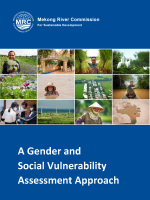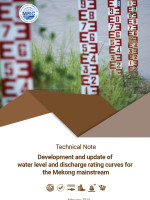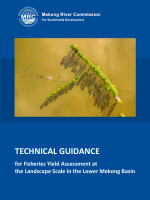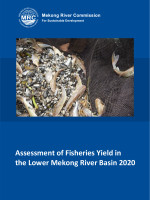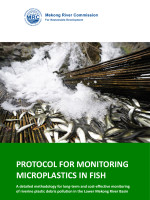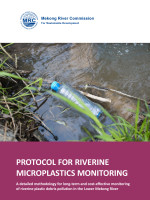Publications
FS MRC ARF Report Audit 31 Dec 2023
Download | Published on: 14 May 2024 | Language: English
FS MRC EF Report Audit 31 Dec 2023
Download | Published on: 14 May 2024 | Language: English
FS MRC BF Report Audit 31 Dec 2023
Download | Published on: 14 May 2024 | Language: English
FS MRC Consolidated Report, Audit 31 Dec 2023
Download | Published on: 14 May 2024 | Language: English
A Gender and Social Vulnerability Assessment Approach
The report on an approach for gender and social vulnerability assessment is a supporting tool – or a guiding note – to assist the MRC to conduct the gender and vulnerability assessment in the Lower Mekong Basin. While the approach focuses on floods, droughts, and extreme storm events for the MRC’s future application, the overall gender and vulnerability framework described in this report could be applied to water resource development in the Mekong. It describes the steps for calculating exposure, sensitivity, and adaptive capacity components to determine an overall vulnerability score at the province level for each of the Mekong countries, which will shed light on possible strategies and measures to reduce vulnerability and achieve greater gender equality.
Download | DOI: 10.52107/mrc.bjk3zl | Published on: 08 Mar 2024 | Language: English
Development and update of water level and discharge rating curves for the Mekong mainstream
This technical note is an update of analysis of the rating curves for mainstream and tributaries of the Mekong River for 2009-2012, published in 2013, discussing the approach and methodology of rating curve establishment. The current publication underscores the Mekong River Commission Secretariat’s (MRCS) commitment to advancing integrated data management. The MRCS adopts the Time Series Management Software, AQUARIUS, to migrate rating curve development. This shift aims to establish a centralised, easily maintainable system, ensuring a reliable source of accurate water data. The transition of rating curve development to AQUARIUS is anticipated to enhance the efficiency, accuracy, and defensibility of water data management processes.
Download | DOI: 10.52107/mrc.bjv4xx | Published on: 20 Feb 2024 | Language: English
Technical guidance for fisheries yield assessment at the landscape scale in the Lower Mekong River Basin
The Technical Guidance aims to establish a systematic framework for generating, acquiring, and analyzing data using GIS in order to estimate the yield of fish and other aquatic animals (OAAs) from the Lower Mekong Basin. This approach, which is based on catch data from fishers, provides a novel method to determine the yield per unit of habitat area and extrapolate catch data from the Basin. By doing so, it offers increased certainty to all stakeholders involved in joint fisheries initiatives, particularly in transboundary areas, by clarifying roles and responsibilities. In addition, the document outlines quality control procedures for ensuring the reliability of the data, including fish catch verification, data validation, and method calibration.
Download | DOI: 10.52107/mrc.bgu8bl | Published on: 06 Feb 2024 | Language: English
Assessment of fisheries yield in the Lower Mekong River Basin 2020
MRC conducts periodic assessments of fisheries yield in different regions of the Lower Mekong Basin ):MB) to inform policy decisions and understand trends in catches and the value of aquatic living resources over time. The assessments conducted in 2020 suggest that the annual finfish yield from the LMB falls within the range of 1.51 to 1.71 million tonnes, while the harvest of other aquatic animals (OAA) is approximately 443,000 tons. These findings reveal a considerable decline in catches, amounting to approximately 25-30%, compared to the assessments conducted in 2000 and 2010. The estimated value of the fish catch varies from USD 7.13 billion to USD 8.37 billion annually. In addition, the estimated value of the OAA harvest is approximately USD 1.13 billion.
Download | DOI: 10.52107/mrc.bivw7w | Published on: 05 Feb 2024 | Language: English
Protocol for Microplastic Monitoring in Fish
A detailed methodology for long-term and cost-effective monitoring of riverine plastic debris pollution in the Lower Mekong River Basin
With a recent study identified the Mekong River as one of ten rivers to contribute over 90% of plastic debris to the world’s marine environment, there is an urgent need for a reliable data and information on riverine plastic debris pollution and their impacts to the aquatic environment of Mekong River. This Protocol for Monitoring Microplastic in Fihs has been developed and finalized as one of three protocols of the MRC’s Detailed Methodology for the Long-term and Cost-effective Monitoring of Riverine Plastic Debris Pollution in the Lower Mekong River Basin (LMB). The finalization of the detailed methodology was made possible through the concerted efforts and commitment of the MRC Member Countries and support of experts at national, regional and global levels, and included rigorous processes of consultations, capacity building, and piloting to ensure that the methodology is adapted to the situation of the LMB. The methodology aims to provide the much-needed data and information for an improved knowledge and understanding on the pathway and behaviors of plastic debris pollution in the LMB, from land-based sources to riverine environment, and ultimately to the marine environment. Information derived from the long-term implementation of methodology can be used to assess the effectiveness of plastic waste management the LMB.
Download | DOI: 10.52107/mrc.bhv7va | Published on: 19 Jan 2024 | Language: English
Protocol for Riverine Microplastics Monitoring
A detailed methodology for long-term and cost-effective monitoring of riverine plastic debris pollution in the Lower Mekong River
With a recent study identified the Mekong River as one of ten rivers to contribute over 90% of plastic debris to the world’s marine environment, there is an urgent need for a reliable data and information on riverine plastic debris pollution and their impacts to the aquatic environment of Mekong River. This Protocol for Riverine Microplastic Monitoring has been developed and finalized as one of three protocols of the MRC’s Detailed Methodology for the Long-term and Cost-effective Monitoring of Riverine Plastic Debris Pollution in the Lower Mekong River Basin (LMB). The finalization of the detailed methodology was made possible through the concerted efforts and commitment of the MRC Member Countries and support of experts at national, regional and global levels, and included rigorous processes of consultations, capacity building, and piloting to ensure that the methodology is adapted to the situation of the LMB. The methodology aims to provide the much-needed data and information for an improved knowledge and understanding on the pathway and behaviors of plastic debris pollution in the LMB, from land-based sources to riverine environment, and ultimately to the marine environment. Information derived from the long-term implementation of methodology can be used to assess the effectiveness of plastic waste management the LMB.
Download | DOI: 10.52107/mrc.bh5hvu | Published on: 19 Jan 2024 | Language: English




